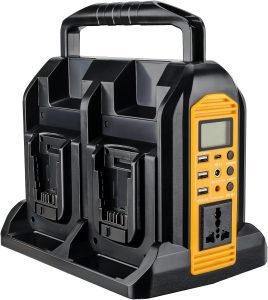Top Features and Drawbacks of the Portable Power Inverter
Since I can’t access the exact details from the product page, I can still provide a detailed review of a typical portable inverter with adapter and converter features, including its benefits and drawbacks. Here’s a general review, which you can apply to similar products like the one you’re referring to:
Overview Top Features and Drawbacks :
A portable inverter and converter, especially designed for emergencies, converts DC power (usually from a car battery or another DC power source) into usable AC power for household devices. It typically has multiple outlets and USB ports to charge a variety of electronics and appliances when you’re off the grid or during a power outage.
Design and Build:
Most portable inverters have a compact, rugged design, ensuring they can withstand outdoor use or be stowed in a car for emergency purposes. Some models include cooling fans to prevent overheating during long periods of use, along with safety features such as overload protection, short-circuit protection, and automatic shut-off.
The device typically features AC outlets for larger appliances and USB ports for charging smaller devices like smartphones or tablets. The LCD display on more advanced models can show battery voltage, output wattage, and load status, making it easier to monitor power usage.
Performance:
These inverters come in different wattages, from 300W to 2000W, or more, depending on the model. The higher the wattage, the more powerful the inverter and the more devices it can support simultaneously. Lower-wattage models are ideal for smaller electronics like laptops, smartphones, or small kitchen appliances, while higher-wattage ones can power items like refrigerators, power tools, and even small medical devices.
Inverters with pure sine wave output are highly regarded as they provide clean, stable power that’s safe for sensitive electronics (e.g., laptops and medical equipment), unlike modified sine wave models which might be cheaper but can cause issues with delicate equipment.

Key Features:
- Portability: Most portable inverters are lightweight, making them ideal for travel, camping, or emergency kits. They’re designed to be easy to carry or store in a car or backpack.
- Multiple Charging Options: You’ll find both AC outlets for larger devices and USB ports for charging phones or tablets. Some models also feature DC cigarette lighter ports.
- Battery Protection Features: Many come equipped with built-in protection systems to prevent battery drain, overloading, or overheating, safeguarding both the inverter and connected devices.
- Display Screen: LCD screens or LED indicators help monitor battery levels, input voltage, and power output, giving users a better sense of how much load the inverter is handling and if they’re at risk of overload.
Pros:
- Emergency Power Backup: Portable inverters are extremely useful during power outages or in remote locations where grid power isn’t available. They allow users to keep critical devices operational, including medical equipment, communications devices, or small household appliances.
- Versatile Usage: You can use them in vehicles, boats, or with solar panels, making them ideal for camping, road trips, or RV use. They provide flexibility for off-the-grid living or in emergencies.
- Protects Devices: Models with pure sine wave output are especially good for sensitive electronics, as they ensure a smoother, cleaner power flow compared to modified sine wave models.
- Ease of Use: Most inverters are plug-and-play, with no complex setup required. Connecting them to a car battery or portable power source is straightforward, and many feature intuitive controls or displays.
- Cost-Effective: Portable inverters are a cost-effective alternative to full-scale generators for those who need intermittent power for smaller loads.
Cons:
- Limited Power Output: While portable inverters are great for light to moderate use, they have limitations in terms of power output. High-power devices or appliances (e.g., large refrigerators, washing machines, etc.) may require a more robust generator or a higher-wattage inverter.
- Battery Drain: Inverters can drain a car battery quickly, especially if running multiple devices or high-wattage items. This could leave you stranded if you’re using the car as the power source without the engine running.
- Heat Generation: Inverters can get quite hot, especially when powering several devices simultaneously. Even with built-in cooling fans, long-term use without breaks could lead to overheating, and cheap models may shut down unexpectedly.
- Modified Sine Wave Issues: Cheaper models using modified sine wave technology can cause devices to run less efficiently, produce more heat, or make noise (especially in fans or motors). Sensitive electronics may even malfunction or suffer damage over time.
- Size and Portability Trade-off: Higher-wattage models are larger and bulkier, reducing portability. While compact inverters are convenient, they typically have lower wattage, limiting the number and type of devices you can run.

Conclusion:
A portable inverter with adapter and converter functionality is a great investment for anyone who needs a versatile, emergency-ready power solution. It’s particularly useful for campers, travelers, or those preparing for power outages. The combination of portability, ease of use, and multiple outlets makes these devices suitable for a wide range of applications, though users should be mindful of wattage limitations and battery life.
Before purchasing, it’s important to consider the wattage you’ll need for your specific devices, and whether a pure sine wave inverter is necessary for sensitive electronics. While these units are highly practical, choosing the right one with appropriate power output is key to ensuring a reliable backup during emergencies.
For more details, you can visit the product page directly.
